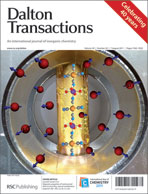A series of 1-alkyl-4-aryl-1,2,3-triazoles (1-methyl-4-phenyl-1,2,3-triazole (1a); 1-propyl-4-phenyl-1,2,3-triazole (1b); 1-benzyl-4-phenyl-1,2,3-triazole (1c); 1-propyl-4-p-tolyl-1,2,3-triazole (1d)) have been prepared through a one-pot procedure involving in situ generation of the alkyl azide from a halide precursor followed by copper catalysed alkyne/azide cycloaddition (CuAAC) with the appropriate aryl alkyne. Cationic Re(I) complexes [Re(bpy)(CO)3(1a–d)]PF6 (2a–d) were then prepared by stirring [Re(bpy)(CO)3Cl] with AgPF6 in dichloromethane in the presence of ligands 1a–d. X-ray crystal structures were obtained for 2a and 2b. In the solid state, 2a adopts a highly distorted geometry, which is not seen for 2b, in which the plane of the triazole ligand tilts by 13° with respect to the Re–N bond as a result of a π-stacking interaction between the Ph substituent and one of the rings of the bpy ligand. This π-stacking interaction also results in severe twisting of the bpy ligand. Infrared spectra of 2a–d exhibit νCO bands at ∼2035 and ∼1926 cm−1 suggesting that these ligands are marginally better donors than pyridine (νCO = 2037, 1932 cm−1). The complexes are luminescent in aerated dichloromethane at room temperature with emission maxima at 542 to 552 nm comparable to that of the pyridine analogue (549 nm) and blue shifted relative to the parent chloride complex. Long luminescent lifetimes are observed for the triazole complexes (475 to 513 ns) in aerated dichloromethane solutions at room temperature.

You have access to this article
 Please wait while we load your content...
Something went wrong. Try again?
Please wait while we load your content...
Something went wrong. Try again?


 Please wait while we load your content...
Please wait while we load your content...